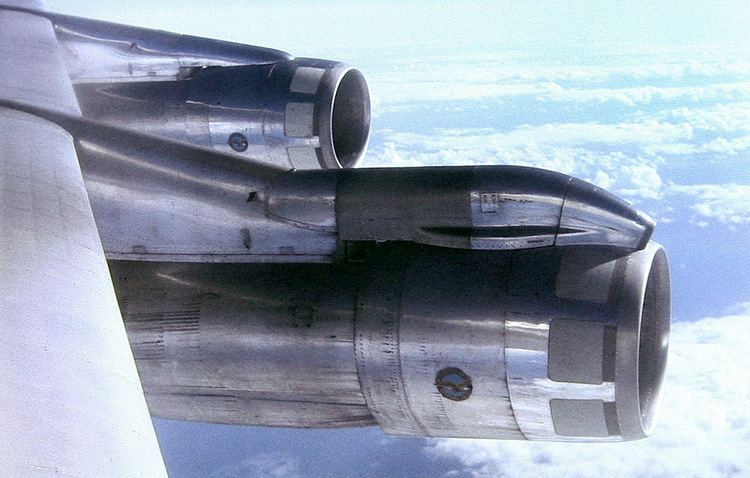 | ||
A podded engine is a jet engine in a pod, typically attached below the wing or to the tail of the aircraft. The pod itself is called a nacelle.
Contents
- Fuselage mounted podded engines
- Overwing podded engines
- Over fuselage podded engines
- Military aircraft
- Advantages
- Disadvantages
- References
Placing engines on the wing provides beneficial wing bending relief in flight. The further the engines are away from the fuselage the greater the wing bending relief so engines buried in the wing root provide little relief. Almost all modern large jet airplanes use engines in pods located a significant distance from the wing root for substantial wing bending relief. The pods are in front of the wing to help avoid flutter of the wing which, in turn, allows a much lighter wing structure. Locating the pod below the wing provides each engine with air undisturbed by the fuselage or wing.
Fuselage-mounted podded engines
Smaller jet airplanes like the Cessna Citation are generally not suited to podded engines below the wing because they would be too close to the ground. This is also the case with aircraft designed to operate from unimproved grass or gravel runways. Instead, in these cases it is common to mount two (or occasionally four) podded engines located at the rear of the fuselage, where they are less likely to be damaged by ingesting foreign objects from the ground.
This mounting location provides no wing bending relief but, following an engine failure, does offer much less yaw due to asymmetric thrust than would wing-mounted engines. Careful examination of such engines will show them typically mounted nose-high. These engines are mounted to face the local flow of air, and the local airflow at the airplane's tail is typically descending with respect to the centerline of the aircraft's fuselage.
Overwing podded engines
Unusual designs that deviate from the norm are the VFW-614, Hondajet and the Softex Aero V24L, which place the podded engines clear above the wings to maximize the distance between ground and engine and therefore minimize the likelihood of foreign object damage.
The Antonov An-72 and the Boeing YC-14 also place their engines above the wings, but very close to the wing. This placement utilizes the Coandă effect allowing a lower minimum flight speed and decreasing the amount of runway needed for takeoff and landing (i.e. STOL).
Over fuselage podded engines
Another unusual scheme is to mount the engine in a pod above the fuselage. The Heinkel He 162, and the Cirrus Vision SF50 are two examples. In both cases the idea is to mount the engine where it will receive good air flow, be distant from the ground to avoid foreign object damage, and not occupy fuselage space. The Piper PA-47 PiperJet is similar except the pod is attached to the tail above the fuselage, and not to the fuselage itself.
Military aircraft
Some jet fighters use podded engines, typically under and mounted directly to the wing. An example was the Messerschmitt Me 262, which had the nacelles mounted directly under the wings, with no pylons being used. The A-10 Thunderbolt II ground-attack aircraft uses fuselage-mounted podded turbofan engines. The Heinkel He 162 had a single BMW 003E jet engine in a pod mounted over the fuselage.
Stealthy designs do not use podded engines. Instead the engines are contained within the fuselage to minimize radar cross section.
Many military transport aircraft, bombers, and tankers use podded engines.
Advantages
Podded engines...
